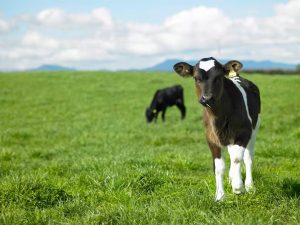
American agricultural abundance has fed the world for decades, but in the past few years, that has faltered. Agricultural economist Dan Basse fears that the decline of globalization and an economic and political rift between the U.S. and China puts U.S. farmers on the losing end of these changes.
“The split between the G-7 countries and the BRICs likely will culminate in differing trade patterns that work against the U.S. farmer,” Basse says, referring to the acronym for Brazil, Russia, India, and China. “There is more ag policy (and geopolitical) uncertainty today than since the early 1970s,” he says.
Basse, founder of the agricultural risk-management and advisory firm AgResource, grew up on a Wisconsin dairy and grain farm and started in the agriculture commodities business in 1979. He spoke recently to Barron’s about the impact of geopolitics on U.S. farmers, food inflation, and where he sees the future of agriculture. An edited version of the conversation follows.
Barron’s: How have agricultural trade trends changed over the years?
Dan Basse: When I first got into this business in 1979, the U.S. satisfied 62% of agricultural trade. Now we’re down to about 11%. Demand is still rising globally as the population expands, but we’ve seen this behemoth named Brazil come on to the scene. Brazil is now the world’s largest soybean and corn exporter—crowns we thought the American farmer would hold for many, many years.
Ag trade has really suffered in the past few years. The American agricultural trade deficit is at $42 billion, a record. China was traditionally our top ag importer for years, but this year it is Mexico, then Canada. China ends in third place.
How did the Trump tariffs affect trade with China?
During the trade war in 2018, the Trump administration put tariffs on China. In 2019, we signed an agreement that was supposed to be for two years, that China would import between $40 billion to $50 billion of ag goods a year. The Biden administration kept those tariffs but, for whatever reason, didn’t hold China to the agreement.
In 2023, China bought about $35 billion in ag goods, but that’s down to about $22 billion so far this year. In the past 12 months, the Chinese decided that maybe relying on the U.S. as a primary ag exporter isn’t good, so they have been buying wheat from Russia, a little corn from Argentina, and corn and soybeans from Brazil.
What should the incoming Trump administration focus on in agriculture?
Agricultural export opportunities should be front and center in terms of supporting farm income. It’s what gets futures markets excited.
I worry that, as we have moved from being a global world, we’re in what I call a duopoly of economic and political power now developing between Washington and Beijing. Ultimately, if the rhetoric doesn’t change against China, China will find its food from others, and it is leaving the American farmer out. If we lose them, there really is no replacement. It isn’t that you can’t develop India or Africa into a China at some point, but it’s years and years away.
During the campaign, Trump advocated for 60% tariffs on Chinese goods. What might be different this time if the administration tries to negotiate a deal to buy farm products?
I don’t think China was prepared for the first trade war. In this trade war, if Trump initiates one, I believe they will be much more prepared. They have sizable reserve food stocks. They have been principally buying most of their corn and soybeans from Brazil. I’m not sure the fight will be as easy as it was back in 2018 and ’19. The Chinese will be much more difficult to deal with.
The Chinese see themselves as decoupling from the U.S. and moving more toward those countries involved in the Belt and Road initiative [China’s global infrastructure development strategy], which for agriculture would be Russia, and principally Brazil and Argentina.
Maybe President-elect Trump can get a deal, but it is going to take considerable time, and U.S. farmers need to be patient for the fights that are ahead. In 2018 and ’19, the administration, through the USDA’s Commodity Credit Corp., handed out so-called Trump Bucks of about $28 billion to farmers. [CCC is an agency that can borrow money from the U.S. Treasury. At the time, it gave agricultural assistance to pay certain farmers who lost money during the trade fight with China, and also bought surplus commodities.]
I suspect that, as in 2018 and ’19, CCC payments may be how farmers stay patient as we somehow rebuild ag export markets. I know tariffs are the hammer and everybody else is a nail, but we’ll really prove whether this concept is a little more effective this time around.
Year to date, corn prices are down 15% and soybean values are 20% lower and sitting near four-year lows. What is weighing on prices, besides weak export demand?
It was a big harvest, so with more supply, prices headed lower. Even though it was the hottest summer on record overall, in the central U.S. temperatures were moderate and moisture was sufficient enough. That means we are going to have record yields this year. If we can’t send our crops to an end user, it takes a lot longer to chew through our supply. Crop prices will have a longer-term bearish tail until we can find a new demand driver.
Net farm income is down 31% since 2022, the largest two-year drop on record. In addition to low crop prices, what else is causing farmer revenue to fall?
As farmers start to plan for 2025 cropping decisions, variable costs will be higher than they were this year. That is largely due to fertilizer and seed costs, the two biggest components.
Where are production costs relative to futures prices? Will farmers lose money this year?
The national average production cost for corn is $4.69 a bushel, and for soybeans, $10.97 a bushel. CBOT [Chicago Board of Trade] corn futures are around $4.25 and soybean futures are around $9.80. Farmers will have an income, per se, but will lose money relative to their input costs. If you own your own farmland and aren’t paying land rent, that’s one thing. Farmers who rent land, which is about 30% of the U.S. farm population, will struggle and won’t have income this year. It will be a sparse year, but such is the cycle of agriculture.
You experienced the 1980 farm crisis. Is a repeat a worry?
I don’t think so. In the 1980s, farmers were overleveraged. That caused distressed farmland sales, and we saw a big drop in the land market. Data from the different land-grant universities suggest that 70% of farmland is paid for, so the farmer has used the financial bounty of recent years to pay down debt. We are expecting this downturn to be more of an operational or revenue hit.
As farmers make their 2025 planting decisions, where might they cut back, and how will that impact companies in the ag industry?
They will look at their cost structure around seed, fertilizer, or equipment. My guess is they’ll cut back on fertilizer first, since some of that builds up in the soil. The only thing corn farmers can’t do without every year in a big way is nitrogen, but they can cut back on phosphates and potassium. Farmers may say they won’t fertilize as heavily this year. You can get away with not fertilizing for one year.
During the boom times, everyone had their hands in the back pocket of the farmer, and they have been slow to pull their hands out. But suppliers are going to have to budge. Already you’re seeing pressure on the equipment dealers. Farmers can say to their Deere or Case [sales reps], I have been changing equipment every three years, I’m going to lengthen that to five years, or I’ll stop lease payments. If the farmer gets his way, he’ll then go to the seed dealers and say, I know you spend a lot on technology, but you have to help me out here. There could be some adjustment with landlords on land rents.
It’s not all gloom and doom for U.S. agriculture. Cattle producers are reaping record beef prices.
Retail beef prices last month were around $8.50 a pound, a record, supported by a very strong economy and consumer demand. We have also had the smallest U.S. beef-cow herd since 1961. That small beef-cow herd will take time to replenish, as we are only in early days for the expansionary phase.
The U.S. dairy industry, interestingly, is helping to supply more beef cattle. Dairy farmers are able to take 10% of their herd and breed a Holstein cow, or another type, with a Black Angus bull to create a crossbreed calf where the marbling is good, the ability to convert grain into beef has been good, and the consumer likes it so far. This is the first time the dairy industry is helping the beef industry get additional supply, and it has also helped the dairy industry do well.
Are we seeing consumers switching from pricey beef to cheaper pork or chicken?
Americans consume the same amount of pork every year. We’re seeing chicken consumption rising. Poultry fatigue, where consumers tire of eating chicken, hasn’t set in. In a broad sense, the strong economy and disposable income have really helped out. One postpandemic trend we’re seeing is that Americans are still consuming more food away from home than at home. This includes things like ordering food from Grubhub, where it’s prepared away from home but delivered to home. As we consume more meals away from the home, you’re seeing protein demand hold much steadier than before, with less switching from a menu perspective.
High grocery prices have been a top concern for people, although consumer price data show food prices coming down. How much does the price the farmer receives translate to what we see on the supermarket shelves?
The most recent data from the USDA say farmers receive 14.9 cents for each food dollar. The other 85 cents goes to the middleman, packaging, transportation to market—all those things add up to what you’re seeing in terms of grocery prices. What farmers are paid, the farmgate price for products like milk or pork and poultry, for example, aren’t too different from 20 years ago.
On the beef side, prices have moved up. Americans, for whatever reason, like beef and have been willing to spend more dollars on it. Hamburger, at $8.50 a pound retail, is going to remain in short supply. We all look at fast food as being a cheap meal, and we get a Big Mac—or whatever it may be—for dinner at night.
What is the future of U.S. agriculture?
Soil health will be the next discussion American agriculture needs to have. What can we do to back away from using maybe as many chemicals as we do, and how do we take care of the fertility for generations to come? We’re making progress on soil health. It’s really the next revolution in farming, but we haven’t done a very good job studying it.
We need to know the holistic picture and how the microbes and bacteria and everything all act together. What will help us save water and carbon, and what will help us in fertility? As a farmer myself, I say we do what we do to take care of the soil. But we need science and leadership to help us understand what we’re doing. As I watch Elon Musk land spaceships, I think, we know more about what is 200 miles above our heads than what is two feet under our shoes.
Thanks, Dan.
You can now read the most important #news on #eDairyNews #Whatsapp channels!!!
🇺🇸 eDairy News INGLÊS: https://whatsapp.com/channel/0029VaKsjzGDTkJyIN6hcP1K

























